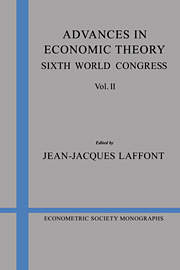Book contents
- Frontmatter
- Chapter 1 Behavior under risk: recent developments in theory and applications
- Chapter 2 Financial contracting theory
- Chapter 3 Collusion and the theory of organizations
- Chapter 4 The nature of incomplete security markets
- Chapter 5 Incomplete financial markets and indeterminacy of competitive equilibrium
- Chapter 6 Endogenous fluctuations
- Chapter 7 Equilibrium in competitive, infinite dimensional settings
- Chapter 8 Infinite-dimensional equilibrium theory: discussion of Jones
Chapter 8 - Infinite-dimensional equilibrium theory: discussion of Jones
Published online by Cambridge University Press: 05 January 2013
- Frontmatter
- Chapter 1 Behavior under risk: recent developments in theory and applications
- Chapter 2 Financial contracting theory
- Chapter 3 Collusion and the theory of organizations
- Chapter 4 The nature of incomplete security markets
- Chapter 5 Incomplete financial markets and indeterminacy of competitive equilibrium
- Chapter 6 Endogenous fluctuations
- Chapter 7 Equilibrium in competitive, infinite dimensional settings
- Chapter 8 Infinite-dimensional equilibrium theory: discussion of Jones
Summary
There is little I can possibly add to the thorough account of the current state of equilibrium theory with infinitely many commodities that has been given in the chapter of L. Jones. But since the duty of the commentator is to offer comments I will oblige by touching on two points. The first concerns a contrast between the analytical treatment of exchange and of production economies, the second refers to the difficulties to extend the theory to environments where the first fundamental theorem fails and, in particular, to incomplete markets economies.
But before plunging into my specific comments perhaps I will be allowed a word on the purposes of the theory. The following observation is evident enough but it nonetheless bears repeating. While from a purely formal point of view an equilibrium model with infinitely many commodities includes, and therefore generalizes, the standard model with finitely many commodities, the justification of the theory is not generality but, on the contrary, concreteness. If all we wanted to know is, say, that an equilibrium exists we would do as well with the finite number of commodities model. After all the number of commodities can be arbitrarily large and since large can be very large indeed there can be no loss of substance in doing so.
- Type
- Chapter
- Information
- Advances in Economic TheorySixth World Congress, pp. 444 - 450Publisher: Cambridge University PressPrint publication year: 1993

